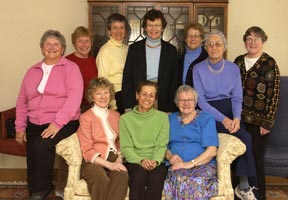Changing Roles
The history of the St. Lawrence women’s
organization reflects the evolution of the status of women
in society.
By Maxine B. Williams
 The story of the Laurentian Dames/Laurentian Women’s Association
represents a part of St. Lawrence history and changes that
occurred not only at the University but also across society.
The story of the Laurentian Dames/Laurentian Women’s Association
represents a part of St. Lawrence history and changes that
occurred not only at the University but also across society.
The first
Laurentian Dames president was Kate Seelye, wife of President
Laurens Seelye. Hand-written
minutes in the University archives state that the first meeting
was on May 29, 1938, at Mrs. Seelye’s home. Eligible for membership
were the women of University families and women holding responsible positions
in the University. In March 1940, Mrs. Seelye stated in her annual
report that the organization’s reasons for existence were “to
serve the college in every way possible, and … to be a means for
better acquaintanceship and to (create) a sense of unity in a common cause
among the housemothers and faculty wives.”
Activities
during the early years were primarily social. The wives furnished
tea for the annual faculty meeting and for the reception for
seniors and parents at Commencement. Over the years interest groups
were added for book discussion, bridge, needlework, tennis,
golf, skiing, international dining, “vicarious
voyagers,” bowling, furniture refinishing and whatever new interests
arose.
Effects
of World War II are seen in minutes of the 1940s. Several bridge
parties were held to benefit the Bundles for Britain relief
program. In
1942, volunteers were requested to help with surgical dressings. Some
members complained about having to use their sugar rations
to make cookies for University functions; the Dames voted to
purchase a sugar supply or to have a different refreshment choice.
In 1946, the Dames held food sales and bridge parties to raise
money for a nursery school, and eventually for a scholarship. In
the ’50s, the school, which accommodated about 25 children, was moved
to Vetsville, probably to benefit the wives of veterans who
were now students. The
school continued into the 1970s.
A
program for newcomers started early on and expanded through
the years. By
the 1980s, members of the hospitality committee were to call
on each newcomer and provide directories, maps, events programs
and extensive information on area schools, shopping, hospitals,
housing and even repairmen to help the newcomers adjust to
their new environment and feel a part of the University community.
The
organization was not without controversy. Some members complained
that they were too often asked to support various student charitable
activities, prompting a reminder that “LD” was “primarily
a social vehicle and not a service organization."
In 1979
came a larger issue about the organization’s name. Members were asked
to vote on whether to retain “Laurentian Dames” or change to
one of three new names. “Laurentian Women’s Association” (LWA)
was the narrow winner. Membership eligibility was broadened to “women
who are or whose husbands are in current full-time professional,
academic or administrative employment status with SLU,” and the purpose
of the organization was amended to “closer bonds of friendship (and)
service to the University and the community.” The group helped
for several years with the annual Red Cross blood drive on
campus.
Especially
popular in this period was the annual Christmas Dinner, changed
in 1981 to the President’s Holiday Dinner. In 1990, LWA sponsored
an April Fool’s Day carnival, complete with hot dogs, races, a scavenger
hunt and Silly Dwilly the clown.
The last
president was Lois Ann FitzRandolph, 1990-94. When she wished to
step down, no one was willing to take over. She also says she
felt the University administration no longer seemed supportive.
The decline of interest in the LWA paralleled a national and
generational change in women’s views. In the 21st century,
more women are working; priorities for the use of their time
are not as they were at Mrs. Seelye’s home in May 1938.
Some
vestiges remain. Lunch Brunch, started in 1978-79, still meets once
a month during the academic year in the room where the leadership
plaque resides. Former
presidents mention the warm welcome that newcomers received;
programs on culinary tricks or fashions; pride in the cookbook
and directories; and the friendships that developed. One notes that
the “organization
outlived its usefulness as the nature of appointments at St.
Lawrence changed and more women had professional lives of their
own.”

